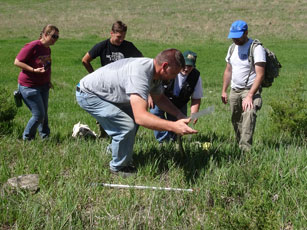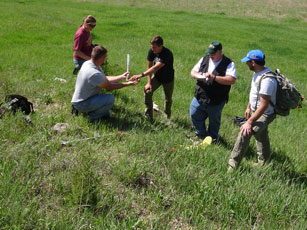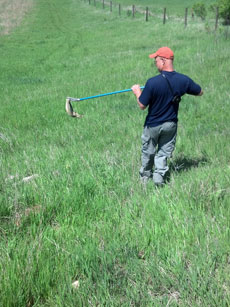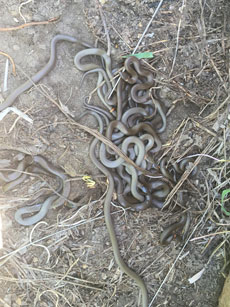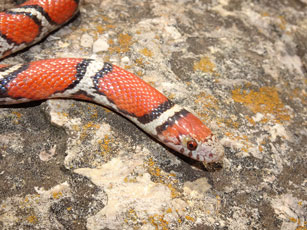
5-14-17
Trip Details
Trip Details
Location: Plymouth County, Iowa
Weather: Windy and clear, high of 82 degrees
Time: 11:00 am
Herpers: Elizabeth Owens, Dan Fogell, Chris Visser, Will Heyl and Jim Scharosch
Account by: Jim Scharosch
Photos by: Jim Scharosch (exept photos of me that were shot by Don Becker)
It was prarie rattlesnake day, so we headed out to the site to meet up with the rest of the group. This is an area that Dan Fogell has been studying for a long time. In the past he has radio tracked animals at the site, and still pit tags the snakes to keep a handle on the population. We met up late in the morning and after visiting for a bit headed up the hillside. This site is an anomoly in the area of Iowa called the Loess Hills. Most of the Loess Hills are just that, big dirt hills. This site is different because there are some small rock outcrops on this loess hill. Those rock outcrops are probably what has led to this singular population of prairie rattlesnakes hanging on in western Iowa.
We walked the site, checking badger burrows, yucca plants and the short grass itself for snakes. We worked the entire top of the hill and didn’t see any rattlesnakes. That didn’t bode well for the day.
We did turn up a couple of Milksnakes under rocks. The first was small and in poor shape so I only grabbed an in hand shot.
The second was very nice.
I had really hoped to see some milks from this area because I thought they would be quite different from the ones we always see in eastern Iowa. They tended to be much lighter in background color, and the saddles were very bright red.
We reached our last chance for a rattlesnake, and area Dan called “The Cinderblocks”. There weren’t any laying out in view, but as Chris tapped on one of the blocks, we heard the distictive sound of a rattle in another nearby block. We managed to coax the snake out of it’s hiding place. It wasn’t too happy and rattled and took a few shots at us as we moved the Prairie Rattlesnake (Crotalus viridis) to a more open area for photos.
Dan had to check the snake for a pit tag, so Don got to tube the snake. This is the only safe way to handle a rattlesnake. Dan scanned the animal and determined that it didn’t have a pit tag, so it was a new animal to the study. That was pretty cool. It is always fun tubing a rattlesnake and being able to safely check it out up close. Dan and Chris took the necessary measurements and implanted a pit tag.
After gathering data and taking more photos, we released the snake back to where we found it.
We worked our way back, Don and I checking the majority of the rocks along the way. It’s funny how this area is like a “light” version of Kansas. It’s like Kansas without the kingsnakes. Like Kansas, there were tons of Prairie Ringneck Snakes (Diadophis punctatus arnyi) under many of the rocks.
I didn’t count, but we were probably around 100 by day’s end. Also like Kansas there were a lot of milksnakes. We turned up four more on this hillside.
This milk was really amazing. The light head and background color really popped. It's one of the nicest milks I have seen in Iowa.
We also found another juvenile, and it was really amazing. It’s background color was very light and it had a really high saddle count.
The last milk was really weird looking. It looked a lot like the central plains milksnakes found in western Kansas, but without the black top of the head. It had the very wide black banding around the saddles and the dirty background coloration. It was really cool looking for an Iowa snake.
That was it for the day. We had a lot of fun with the group. We shared a lot of laughs and got to see some cool critters. I really look forward to having a chance to get back out there again sometime.






